The increasingly rapid advancement of technology that we are all
becoming subject to permeates every niche of our existence.
Whether this is necessarily good or bad is up to the individual to decide,
but when it eats its way into a craft which is essentially primitive in nature, it can
only be described as detrimental. Generally, potters in
the West have always directed and controlled the
processes of their craft rather than worked with their
materials in the directions to which they naturally tend.
Now we are reaching a very dangerous stage whereby
craft pottery can either plunge into a sterile
technological environment or return, probably and
sadly too, out of economic necessity rather than the
aesthetic, to its roots. The advent of electricity, gas and
to a certain extent oil, has turned the most creative part
of the potters processes into a mere finishing tool, a
method of mediocrity whereby pots are made
permanent in much the same way as plaster sets in a
mould. Indeed, one can now obtain automatic firing
devices, it has to be wrong to make pots by hand and
then to fire them using computers. Bernard Leach in 'A
Potters Book' wrote, 'There are people who imagine
they can play at potting, condescending in their opinion
from fine art to a craft which they can expect to learn in a
few weeks or months, buying everything ready made
and avoiding drudgery by mechanical devices. Pottery is
still being made and decorated under this mis-
conception, it would be well for both potter and public
to realise that the results of such performances look
precisely what they are, unhappy exhibitions of
dilettantism in a mechanical age'.
The potter has essentially three elements upon which
to bestow his creative powers, those of clay, glaze and
fire, but at the same time he must strive to be true to
these three. For example, if he makes his pots from clay,
they should be seen to be made from clay, it is no good
making a pot as though it were turned from metal. As
potters we have this amazing potential to deviate from
the perfectly symmetrical, even on the wheel. There is
far too much emphasis put on what goes into a glaze,
than what a glaze can do, and likewise with kilns and
firing them. A live flame, especially if it originates from
burning wood, can be used in such a way as to make
formal decoration superfluous if not unnecessary. I have
heard of wood firing and its dramatic effects being
dismissed as an easy alternative, a way of decorating
without decorating, however, if it is used in the same
way as a brush and pigment it is incredibly demanding
physically, mentally and in terms of accumulating
knowledge. One can see what is happening with a brush
and pigment, it is controlled. One cannot see what is
happening inside the kiln, but it is possible to have a
pretty good idea. The following account consists of
knowledge gained largely from hard won experience,
very little is gleaned from published descriptions of
others. While at Farnham, like most other students in an
art college, I had the unique opportunity to be totally self
indulgent-digging holes in the hillside and firing them was my main pre-occupation!
To commence we must go back in time, to when
wood was the only fuel for firing pots, to Japan during
the period from the eleventh to the fourteenth
centuries. The only active ceramic producing localities
during this period became known as the Six Ancient
Kilns, three of these being Bizen, Tamba and Shigaraki.
The early wares from these kilns were fired in a kiln
called the Anagama, or cave kiln. This was simply a tunnel
in the hillside. The location of the kiln was determined
by a favourable land contour and suitable soil
conditions. A sandy soil with a percentage of clay and
no rock was necessary. Limestone or shale in the kiln
wall would upset the stability of the kiln during firing,
and naturally a compact soil was necessary in order for
successful digging to occur. This simple anagama,
usually six to ten feet long, fulfilled all the essential
elements of any kiln. A firemouth for wood burning, a
chamber in which to place the wares and to accumulate
heat, and a flue for the exit of exhaust gases. In this
upward kiln the gases moved by convection, and at the
same time produced enough draught for the rapid
combustion of wood.
Once fired, the kiln was sintered to a hard surface and
became self supporting. The more firings it had the
stronger it became. Long firings were necessary largely
due to the dampness of the earth, the kilns took several
days to reach 1300, fired on cypress and pinewood
which was locally abundant. It took many hours of firing
to drive off the water in the walls of the kiln chamber.
Until the kiln was quite dry, no build up of heat could
take place. Temperature gauging was carried out by eye
which resulted in variations between firings. As a result
of the firing process the pots had rich surfaces, colours
and texture, resulting entirely from the firing, rather
than from the design. The passage of flames through the
setting of the kiln gave random colouring and qualities
to the wares. The most important feature of these pots
was natural ash glazing, the deposit of ash being the
inevitable result of the placement of the pots in the kiln
and the firing cycle. The ash, the by-product of the
burning wood flies through the kiln following the flame
path, thus settling on the pots, and melting to form a
glaze when sufficient temperature has been attained.
The success of ashing was dependent on the fusibility of
the ash and on the length of the firing. Conifers, such as
cypress and pine are especially fusible, and only an
extended period of firing would generate sufficient ash.
The position, extent and the flow of ash was dependent
on the placement of the pots in the kiln, the duration of
the firing, and the temperature achieved. Together with
'flashing' from the flame, and ashing, the pots were also
enhanced by kiln particles, stacking scars (the pots were
simply stacked in the kiln) and packing deformation. No
other tradition has managed to capture so much beauty
from the firing process and at the same time done it with
such innocence. It was not the intention to use the firing
as a conscious means of decoration, it was quite simply
a means whereby the pots became able to perform their
preconceived functions. The main point is that from the
simplest of firing methods some extremely beautiful
pots were created. I cannot help feeling however that
somewhere amidst the battlefield of exhausted men and
piles of wood were potters who, like myself, really got
quite excited by what they were doing.
There are several well proven principles and designs
available for burning wood and firing pots efficiently,
however efficiency does not necessarily contribute.
towards promising pots, indeed quite the opposite. It is
perfectly possible to fire pots with wood using an
extremely efficient kiln and to end up with pots having
no evidences of wood firing upon them. The emphasis in
this case would be one of pure economics, wood as a
cheap fuel forgetting its decorative potential, although
it must not be forgotten that wood is also labour
intensive and requires considerable space and
management. The concern here is the use of wood in a
dynamic manner, not necessarily as efficiently as
possible.
The cross draught principle is logically the optimum
means to extract the most from the elements of wood
firing that are available. Flame and ash pass between the
pots throughout the length of the chamber; in a
downdraught kiln for example the flame passes past the
pots between the shelves, usually the only pots to
capture the excitement are the ones at the top of the
kiln. I have come across one kiln superior to the cross
draught in this respect and that is one belonging to
Takeshi Yasuda which has a flue exit consisting of a
hole in the centre of the kiln floor covered by a raised kiln
shelf. This appears to be an excellent method of
retaining the bulk of ash and dancing flames within the
kiln chamber.
The kiln I built at Farnham turned out to be nothing
more than a sophisticated anagama. Through a
shortage of brick it was built into the ground on a slight
slope, the chamber floor being eighteen inches below
ground level and the ashpit floor four feet below. Having
the ashpit that much lower than the kiln chamber
produced a positive pressure principle, the opposite to
the negative pressure experienced in downdraught
kilns. The kiln chamber had the shape of an elongated
egg; from the outset I realized that a live flame naturally
following its shortest route to the exit from the kiln
would not take time to travel into corners. Thus the kiln
chamber, tapering towards the exit flue, was
constructed with the organic shape of the anagama in
mind. The end result was a kiln utilising both updraught
and cross draught principles, very similar to the draught
of the anagama. The walls of the firebox and ashpit
together with the chamber arch and door were built of
firebrick, the floors made serviceable with a 90% grog
10% clay mix. The chamber arch rose eighteen inches
above ground level at the front of the kiln tapering
downwards towards the flue. By far the best type of
firebox for the combustion of wood is the Bourry, a
system whereby the bulk of wood is burnt suspended
across the ashpit at right angles to the kiln with the ends
of the logs resting on two ledges called the hobs. Thus
the wood burns in mid air and maximum combustion
can take place. The ashes and embers fall into the ashpit
and provide a ready source of preheated secondary air.
With this type of firebox and an ashpit of some six feet in
length I was able to use the effects of flame and ash to
their maximum potential.
The firing of a wood kiln has to be an entirely separate
exercise from the rest of the process, the concern is no
longer with the individual pots, but with a device which
affects all of them together. The demands in terms of
concentration, usually some form of physical stamina
and an almost total reliance on intuition make it
inevitable that pressures of making pots and packing
them in the kiln are forgotten. The packing of the kiln is
the most crucial part of the whole process. It is here that
one decides, to a large extent, the fate of any one
particular pot. What actually happens inside the kiln is
not so much in control as the firing itself. One cannot
really predict the outcome, but it is possible to set things
up so that the so called 'accidentalism' aspect of wood
firing is to a certain extent, calculated. Packing the kiln
at Farnham, though only 25 cu. ft., could take as long as
a whole day. The same psychological problems are
experienced when packing as when decorating pots in a
formal manner, however there is a difference. While
packing a wood kiln one anticipates potential
decoration, it is not possible to see the end result until
the process is completed. Hours can be spent
deliberating where pots should go, rearranging them
and possibly throwing some away. It would take much
good fortune for me to be happy with the pack. It may
have been made too open or too tight or pots that I really
wanted in the best places would not fit.
There are several decorative processes to be
considered while packing. The path of burning gases
through the maze of pots is dynamically creative. This
has to be taken into account, for it carries with it a
natural glaze, that of flyash. It is important to decide
which part of the pot is to receive all this potential
activity, if at all, for expectations can easily be wrong..
The majority of flame will find its easiest route to the
exit, it will favour a large gap in preference to a smaller
one. It is possible, by way of the pack, and particularly
with the cross draught principle, to virtuallly tie knots in
the flame path. This is important because where the
flame, which is far hotter than the kiln temperature,
impinges on a pot, the extreme heat of that flame fluxes
the surface, or in more linguistic terms, causes flashing.
An alternating cycle of oxidation and reduction occurs
naturally in a wood kiln causing the fluxed, exposed
surface of the pot to become reddish, in contrast to the
greyness of the reduced body. Pots that are unglazed on.
the outside can be stacked on the top of, inside or next
to each other. Where they touch the surface cannot be
reoxidised and thus remain grey, or lighter in contrast to
the redness of the oxidised body. This aspect of
decoration is of major consideration while packing,
along with the positioning and size of wads, if used. The
function of wads is either to aid stacking (the use of kiln
shelves is minimal) or to prevent pots from sticking to
each other or to the kiln furniture. This is usually
necessary if high temperatures are attained, or if a lot of
ash is generated. 'Sticking scars' are quite acceptable
but it gets a bit much if pots have to be broken to get
them apart. Wads can be made of clay which leave grey
marks on the pot, or alumina mixed with china clay and a
little bentonite for plasticity. The alumina wads leave
conspicuous white marks, one alternative is to use
seashells which cause scarring on the pot wherever they
are placed. The calcium carbonate of the seashell forms
a eutectic with the silica and alumina of the clay body
and fuses, leaving a scar. The remainder, having been
reduced to quicklime (calcium oxide) in the firing is
easily removable. Additionally, the salt in the seashells
volatilises leaving pleasing marks on the surface of the
pot.
Major consideration must also be given to flame
pattern. In anticipating the path of the flame through
the kiln it is important to remember that the flame will
always follow its easiest route to the exit. Obviously, I
can only speak in detail regarding the kiln described
here, however the criteria should be easily applicable to
any other. Bearing in mind the shape of the chamber and
the cross draught element, if a bagwall is built, be it only
three bricks high, the flame is immediately forced to the
roof of the kiln. Unless there is a large gap in the middle
of the chamber, the flame will then run the length of the
chamber at roof height and drop down to the flue at the
back. The pots in this path tend to be high fired, heavily
reduced and with the bulk of the ash falling on the pots
at the back. The remainder of the kiln, the middle and
bottom front is usually cooler and comparatively pale in
colour. A small bagwall is necessary however to prevent
the flame from travelling along the kiln floor to the flue. I
have experimented with the positioning of large pots,
when packed in the kiln with the pots of more
conventional size. It is not really practical to have one
large pot at the back, for the part of it nearest the flue
tends to be lower fired than the rest of it. Nor is it
practical to place one pot off centre in the middle for this
upsets the flame currents and causes unevenness not to
mention the phsyical problems when packing the space
next to it. Two large pots right at the front will restrict
the flow of flame and ash to such an extent as to make
the firing one big headache. By far the best position on
all counts is to have one large pot right at the front in the
middle. This automatically splits the flame creating two,
major flame paths within the kiln. This in turn creates
greater kiln potential. Firstly and inevitably the ashing
on this large pot can be very interesting, Secondly, the
two flame paths eventually have to converge at the flue,
if not before, and under these conditions, fire flashing
and ashing are at a maximum. It is important to consider
the effect that pots, or stacks of pots in certain
positions, will have on this flame path. With a little
cunning, a maze of eddies can be conjured up, the more
corners the flame has to navigate within the pots, the
greater the flashing. If more ash is desired on some pots
than others these should be packed more loosely than
the rest and in such a position as to be in the anticipated
flame path.
There are many things then to contemplate while
packing. It is at this point that the last say is said, the last
direct influence on the pots carried out. From here on,
although the kiln is to a large extent controlled, it is the
kiln that dictates the final outcome, however this is
influenced by many prevailing factors, some of which
may cause one firing to be completely different from the
next. At this stage the kiln and the firing speak for
themselves but always in close relation to these things.
Half the enjoyment, half the excitement is in the
unpredictability of it all, not knowing whether there will
be but one good pot. The final outcome can be entirely
transformed by the length of the firing, the type of
wood, the amount of moisture in the ground,
atmospheric pressure, the weather and a whole host of
other factors. Indeed, the only explanation I could offer
for a kiln full of orange coloured pots of a tone I never did
achieve again was that on the day of the firing it was
ridiculously hot and atmospheric pressure was much
higher than normal.
It is important after packing and bricking the door to
pause and contemplate what is to come. The right
mental attitude is essential, for many things can cause
the firing to go wrong, half of them directly affecting the
firer. The weather and time of day are the most
influential elements upon morale, not to mention the
effect on the duration of the firing and the atmospheric
conditions within the kiln. Twenty four hour firings
include the night. Rain during the day is bearable, rain at
night, particularly if heavy, can dampen the most
enthusiastic of spirits. The dread of a stormy night is a
force to be reckoned with. High winds are capable of
reversing the kiln, of blowing the chimney down. They
can alter the pull of the chimney drastically, and can
make chaos of controlled stoking. Rain soaks wood, the
ground becomes wet and boggy, the firer becomes wet
and cold, then hot and sweaty, then wet and cold again
as each stoke is repeated. The most difficult hours to
contend with are those preceding dawn. Those first
signs of daylight are such a boost to flagging spirits and
an exhausted body-but they take such a long time to
appear.
A little fire during the evening is a fitting end to the
days packing. This will thoroughly warm the kiln and dry
out any remaining moisture. It is difficult however to
stop and retire home to bed, preferably early. It is
essential I think to start before dawn the next morning,
there is something unique about those first silent wisps
of white smoke mingling with a fresh day. The birds
wake, the dew gleams on the trees, and the little fire
crackles merrily. Such a small fire and so relaxing, yet
warm enough to sort out cold fingers in the winter.
Breakfast is next, but it is short, the magic of the first
few hours, they soon pass. The fire begins to rage, the
flames pour along the firebox floor like a waterfall and
work begins in earnest. Wood must be sorted and
bundled for each stoke, the firebox must be raked
regularly in order to keep all the wood burning, and
wood must be stoked into the kiln with relentless
regularity. It is difficult however in the early stages to
overcome the temptation to force an excess of
temperature against time. For myself, I am sure it has
something to do with the desire to exert the most violent
conditions possible, short of disintegration, upon the
pots. It is satisfying to know that they survived, to know
that they have been subjected to their limits, to their
utmost physical tolerance. To actually see the scars of
flames and the distortion of form satisfies me in the
same way as being able to see that a pot has been made
by taking the clay to its utmost physical capacity. In the
same way, the materials used and the method of firing
impose limitations on what can be made. Coarse clay
will not allow delicate forms, and delicate forms will not
survive excessive kiln conditions. Thus, from a given set
of limitations a distinctive style will emerge. Similarly,
one can take the firing to such a point where the
limitations of the materials begin to take effect, this is a
distinctly creative part of the process. It is a point of
marginal plasticity, when pots with certain forms and
inbuilt weaknesses, stacked in a particular manner will
almost certainly distort. The glazes used are in such a
molten state that they are running down the sides of the
pots, flyash is spontaneously fusing to them and if
enough has accumulated is behaving in a similar
manner. This part of the firing, accounting for a heat
tolerance of no more than ten degrees centigrade, is a
sensitive period. It can be approached with caution, or
with rapidity, it can be frozen by immediate cooling. The
critical factor is when to stop. It is handy to have a
spyhole with a specimen pot in view, so one can watch
and wait for the right moment, to be able to see the
extent of distortion and how far the glaze has run.
Wood varies in calorific value and heat worth from
species to species. Softwoods, especially of the
coniferous type have a greater calorific value then
hardwoods. They also contain a greater resin content,
resin being highly flammable. Another factor of
softwoods lies in their lower specific gravity and more
open texture, which exposes more surface per unit of
weight thus speeding combustion. All this is important
to remember, during firing it usually results in equal
amounts of thin softwood and thick hardwood being
used. Thin wood will provide the immediate release of a
lot of energy, resulting in rapid temperature rise,
whereas thick hardwood will provide mainstays in the
firebox for long periods of time and also promote a slow
but even release of heat. The type of wood used during a
firing can have a marked effect on the atmosphere
within the kiln, and is also influential in the colouring of
ashing. If a lot of pine is burnt, ashing tends to be very
fluid and light green, hardwood will promote drier
ashing and tends to be yellowish. Pine can produce the
most violent of reducing conditions, also great
quantities of black smoke, this sight however is not
necessarily indicative of good reduction. Whatever the
type of wood used, it must be thoroughly dry before it
can realise its maximum heat potential. To fire a kiln with
damp wood is a futile waste of effort, for dampness will
consume at least half the available heat energy in being
driven off. Likewise freshly felled wood will require two
or three years to dry out, and will then still maintain a
water content of some twenty per cent. Even this will
use up a third of the energy available.
Briefly, wood burns in two stages. The first stage of
burning is the combustion of volatile gases driven out of
the wood during the charring process. If one watches
the wood as it is placed in the firebox, it is literally roasted.
The gases pour visibly out of the wood and these ignite
spontaneously even before the wood itself starts to burn
The resin content of the wood plays an instrumental part
here, the greater the resin content the greater the heat
release during this initial stage of combustion. As gases
are being burnt, longer flames are produced. Above
eleven hundred, this part of the burning process will
produce immense flames. As the wood continues to
burn these will gradually recede as the flame length
diminishes and the wood takes on a more steady rate of
heat release. Droplets of resin are also driven out of the
wood, these do not ignite until they have found
sufficient oxygen to do so, usually in the kiln chamber
rather than in the firebox. The second stage of
combustion is from the non volatile part of the wood,
charcoal, in the form of embers. This burns with a
shorter flame, so that heat release is more localised. The
charcoal requires oxygen to burn, and as the bed of
embers in the ashpit builds up the oxygen requirement
for efficient combustion increases in proportion. After a
point, the embers may use up so much oxygen that the
volatile gases cannot burn and pass through the kiln
without releasing energy. In this case, as I have
experienced many a time, usually through a desire for
entertainment rather than substandard firing technique,
an enormous roaring fire of combustion will light up the
whole kiln site, something comparable to near daylight.
The ideal, naturally, is to have the gases buring inside
the chamber, usually achieved when a soft flickering
tongue of flame is issuing gently out of the chimney.
Under these circumstances, unless heavily reducing,
the kiln should be gaining temperature.
However well dried the pots and the kiln are, it is
essential to start slowly. A small campfire for an hour or
so followed by a large campfire for another hour or so
will ensure a slow temperature rise of up to two
hundred. Another two or three hours up to six hundred
is recommended. Anything much faster than this,
though it may not cause disintergration of pots, some
cracking and partial splitting of the clay surface may
occur. Over this period the size of the fire in the ashpit is
progressively increased in size until around six hundred
when wood can be stoked in from the Bourry
firebox door, so that it lies at an angle, with one end in
the ashpit and the other resting on the hobs. It is
important to criss cross the wood as much as possible
so that maximum combustion is achieved by having a
maximum surface area of wood free burning. The
embers from this wood are allowed to accumulate
beneath the hobs in order to bring them up to red heat,
and thus to a point where stoking across the hobs can
commence. The temperature at this point is near to
that where reduction commences, around nine
hundred.
Reduction is achieved by one of two methods.
Inefficiently speaking, one can overstoke, that is
feeding an excess of fuel into the firebox, which in turn
cannot be burned by the available oxygen. This causes
an excess of black smoke from the stack, a factor not
indicative of the state of reduction. It is merely a waste
of heat worth in the form of unburnt gases. Under these
conditions, temperature rise will cease, and in all
probability will fall.
The alternative, and by far the more efficient method
is to decrease the amount of oxygen per constant of
fuel, by closing up the secondary air vent of the ashpit.
Using this method, very little heat potential is wasted,
and although temperature may not rise, it will not fall.
This inevitably calls for an alternating oxidising and
reducing cycle, for under oxidising conditions,
temperature will rise rapidly. Therefore it is necessary to
be constantly aware of proportionate kiln atmospheres
and to react accordingly.
It took many firings for me to learn and understand the
functioning of the Bourry firebox. Temperature rise
after eleven hundred is difficult to achieve, and after
twelve hundred nigh on impossible unless a subtle,
understanding touch is available. Reduction, especially
if fierce, will almost inevitably cause. a drop in
temperature. In order to gain temperature it is necessary
to have a subdued oxidising flame. This flame, as it does
not carry any unburnt, cold fuel, is hotter than the kiln
will ever get, it can be seen as a slender white tongue
flicking into the kiln and dispersing before it reaches the
flues. Under these conditions it is possible to get a
temperature rise of up to forty degrees with one stoke,
though twenty degrees is a normal figure. Severe
reducing conditions with violent, rushing and long, yet
very desirable flames can drop the temperature as much
as sixty degrees, so one has to engineer the stoking so
that a staggered yet gradual rise in temperature is
achieved.
The embers in the ashpit, the by-product of wood
burning across the hobs, are instrumental in achieving
temperature rise. If the embers rise above a certain
volume, the supply of oxygen to the hobs is severely
reduced; it is being used up in burning away the embers,
therefore efficient combustion cannot take place and
temperature rise either stagnates or falls. If the bed of
embers falls below a certain volume, the air entering the
kiln by means of the secondary air port is insufficiently
preheated and causes similar effects regarding
temperature.
The method by which the volume of embers is
controlled is quite logical. If a lot of thin wood is burnt, a
lot of embers accumulate. This is because the thin wood
does not take long to burn through, and will do so before
the bulk of the wood is completely burnt, thus ending up
as embers in the ashpit. Larger logs are advantageous
for a more controlled firing. They take a long time to
burn through, at the same time giving a constant flame
to the kiln. Temperature rise is thus slower, but more
sustained. The embers that do fall in while the stoke is
burning, are sparse but continuous, and are constantly
being consumed with ease and a minimum of oxygen by
preheated secondary air. Thus when the stoke does get
to the point of collapse, there is sufficient combustion
space within the ashpit for the subsequent embers.
Also, if all has gone well, one will have gained twenty
five degrees, five more than the amount that will be lost
due to the violent, reducing flame caused by the embers
falling in (which causes a temporary, but excessive lack
of oxygen). This alternating between a soft oxidising
and a raging reducing fire is sufficient to produce well
reduced pots if maintained, and is also particularly
desirable for its range of colours on the raw clay body.
It is possible to fire for great lengths of time without
causing any large collapse of the stoke, at the same time
maintaining a constant reducing atmosphere and
temperature rise. This is done by periodically stoking
using two or three main supports of large logs covered
with thin pieces criss crossed on top until the firebox is
full. The large logs prevent the smaller wood from falling
in once burnt through, thus it will be free burning in mid
air throughout its entire combustion The large logs fall
in gradually and rarely all at once. Thus in between each
complete fresh stoke, it is possible to fit in two or three
stokes of thin wood on top. In addition to every fresh
stoke, the embers are raked through vigourously, this
keeps them turned and continually burning and
breaking down. In doing so vast quantities of flyash are
generated.
Raking through the embers to do this can be quite a
conscious exercise, and if this is done often enough and
long enough it can promote amounts of glaze on the
pots concurrent with several days firing, even though
the firing may only last twenty four hours or so. It is
important to arrange the pile of embers after raking, just
inside the entrance to the ashpit, and just before the
hobs. This accounts for maximum preheating of the
secondary air, and leaves a clear space underneath the
hobs for the passage and easy combustion of the flame
and gases.
Thus it is quite feasible to control the rate of
temperature rise, and also the ratio of oxidising and
reducing flames, this factor alone is capable of causing
one firing to be completely different from the next.
One would automatically assume that due to
increasing stoking skill and efficient use of wood the
length of the firing cycle would diminish. This was not
the case however, it either remained around twenty two
hours or got even longer, simply out of choice. Up to
a point, the longer the firing cycle the better. Speaking
purely in terms of efficiency, I could fire the kiln in
fifteen hours using a single cord of wood. Why then
would I fire for twenty four hours using two cords of
wood and lose twice as much sweat in the process?
Initially I was obsessed with the effect of ash. I still am,
but that is not all. Between 920oC. and 1250oC. one is
merely setting things up and getting the clay body into a
state where it is technically 'correct'. There is plenty of
ash on the pots but it has not fused, and has only settled
where it will not fall off. Between 1250oC. and 1300oC.
the surface of the clay body becomes sticky and specks
of ash will adhere and fuse spontaneously. It is also at
this point that the flame is at its most dynamic because
the clay surface can more readily respond. Thus it is
inevitable that at some point a long soak is desirable. 1
found it best to soak short of maximum temperature
rather than soaking for a long period at maximum
temperature, I did use some glazes, and this tended to
produce effects concurrent with overfiring.
Initially I would reach 1300oC. and then carry on
firing, soaking the kiln with filthy kiln atmospheres until
such a time as I felt it right to finish, or physical
limitations made it a necessity. This inevitably resulted
in dull colouring of both clay and glaze, and those glazes
high in alkali and iron ran too far, resulting in a distinctly
overfired appearance. Hence I decided to soak forty
degrees short of top temperature for up to six hours,
varying the kiln atmosphere considerably. This is to
promote stark variations in body colour on the pots, a
method of firing similar to the Japanese technique
known as higawari-that of changing fire. I would then
fire slowly with a clean atmosphere up to 1300oC. This
resulted in a much improved firing cycle. Colours of
both glazes and bodies were much brighter, due to the
oxidised end to the firing, and because the end was
slow high clay, high feldspar glazes were not adversely
affected (because of their viscous nature, a rapid rise
usually results in excessive crawling).
CLAY BODY
| High iron | Old stoneware clays mixed with 10% china clay grog and feldspar sand | Coarse |
| High silica low iron | HVAR ballclay | Fine |
| Porcelainous | BBV 80 Nepheline syenite 20 | Vitreous |
GLAZE
| High lime, high iron | Ash glazes | Unstable |
| High clay, high feldspar | Shino types | Stable |
Most clay bodies low in iron will flash well. Very
pleasing dry flashing can be obtained with aluminous
bodies, a siliceous body will promote shiny flashing. I
have pots solely from HVAR ballclay, which with the
combination of ash and fluxed surface look as though
they have been salted. A good shino type glaze will have
a temperature tolerance of anything up to one hundred
degrees although it won't look the same at either end of
the scale. Ash glazes high in flux are a lot more sensitive
than this and thus have a rather more critical
temperature range.
Advantages of using a pyrometer are few, cones are
a much better idea. A pyrometer is beneficial when
learning to fire, it is easy to see whether temperature is
rising or falling, and subsequently to discover why.
Every kiln is individual, and the only way to determine
the right way to fire it is through experience,
experimentation and some calculated guesswork. A
pyrometer may reduce a lot of this work, for it is easy to
see from it the results. What a particular action
provokes.
The pyrometer is however not only sensitive to overall
kiln temperature, but also to flame temperature. The
needle is fairly stable up to eleven hundred after which it
will rise and fall like a yo-yo. A hot oxidising flame will
send the needle rocketing thirty degrees or more, while
a relatively cold, yet violent reducing flame will cause it
to fall. It is so easy to become glued to the needle to the
point of neurosis. With a little experience it is easy
enough to see and feel the rise in accumulated heat.
There will come a point where the pyrometer can be
thrown away and senses relied on entirely, for with a
little practice they are far more sensitive than that
wretched figment of technology.
I found it necessary to start heavy reduction quite
early on, around 920oC. This could then be eased off
after 1100oC., decreasing up to 1260oC. To start much
later than 920oC. resulted in pale, anaemic looking
pots. An hours soak at 800oC. would ensure that all
carbon was burnt off, thus preventing any tendency to
bloat through carbon trapping later on. The kiln would
always stick for two hours or so around ten fifty for no
apparent reason. There are two factors which may
account for this. At some point the kiln structure itself
must reach a certain temperature for any further
internal atmospheric temperature to take place.
Secondly, the kiln is in the ground, and apart from being
a poor insulator, ground holds a large percentage of
water. This must be driven back to quite a considerable
depth before any further temperature rise is attainable.
It is this water content of the kiln that gives the pots
qualities that I believe cannot be achieved in any
conventional kiln. The simple fact that the kiln is dug out
of the ground will leave a distinct mark of individuality
upon the wares. This is usually borne out by subtle
colour variations of the clay body tending towards
pinks. I am also convinced that such stark contrasts of
colour in the clay body of any one pot cannot be
achieved with such effect in a conventiuonal kiln,
without the addition of some artificial means.
As a final note on technique, when I resolved to
wood fire, one reason for doing so was a growing
awareness of the overpowering nature of technological
gadgetry. I wanted to forget knobs, dials, gauges and
complicated firing cycles. However, unbeknown I was
immediately plunging into a self imposed system of pre
planned analysis and calculation, albeit without the
added sophistication of industrial elements. Instead of a
precision made venturi to control air intake, an old
house brick is used to plug up a hole between two more
old bricks. The principle is exactly the same, however it
is the latter method that is more in keeping with the
processes of the craft. If it were not for recording each
firing by means of an analytic graphing system,
reaching conclusions on how best to fire the kiln would
have taken much longer. Whether the method was true
to the means I am still undecided upon. Compromises
always have to be made, it is important that they are
always seen as temporary and eliminated one by one.
As potters we have a moral duty to provide an
education, something we have learned, to the
undiscerning eye of the public at large, for they are so
easily influenced by the wrong things. The question one
then might raise is, how do we convince them that wood
fired; coarse textured pots with ash all over them and
running or crawling glazes are good, and they should
buy them? The answer is that we don't. It is not just a
case of making money, it is a case of making pots. I
make pots because it is my job and I enjoy making them.
Pots made, my job is done, it is then up to others to
decide upon them by whatever criteria they choose to
use. However, as far as the maker is concerned they
must be made in a manner true to his own beliefs, and
hopefully struggling towards his own astronomically
sacrifices and effort, with all sorts of categorical
high standards. One can go to all sorts of lengths and
attitudes, but at the end of it all one has to judge
everything on the pots, that is what it is all about. The
look at, rarely do they consider the processes by which
pots are the final statement, it is the pots that people
they have been made. The craftsman has to provide his
contribution, no matter what magnitude he feels it
represents, and thus bring a little joy into someone's
home, and hopefully at the same time make a little profit
from love.
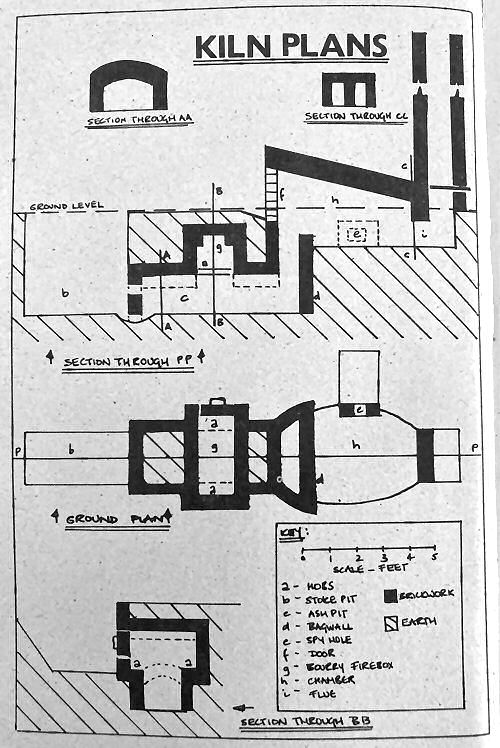
Patrick Sargent kiln design
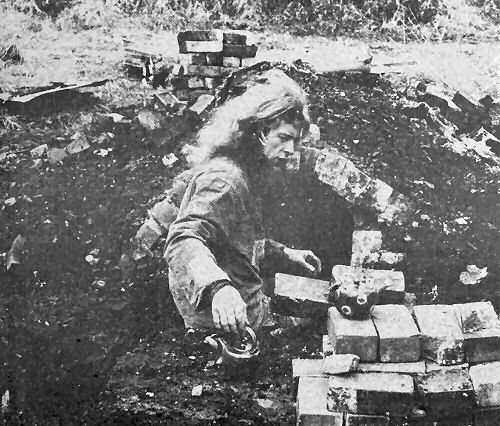
Patrick Sargent
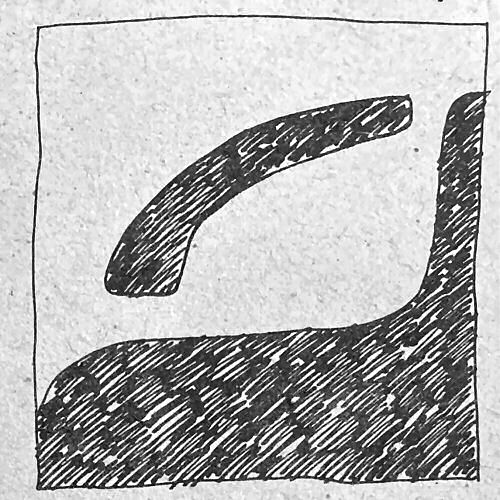
Anagama kiln shape
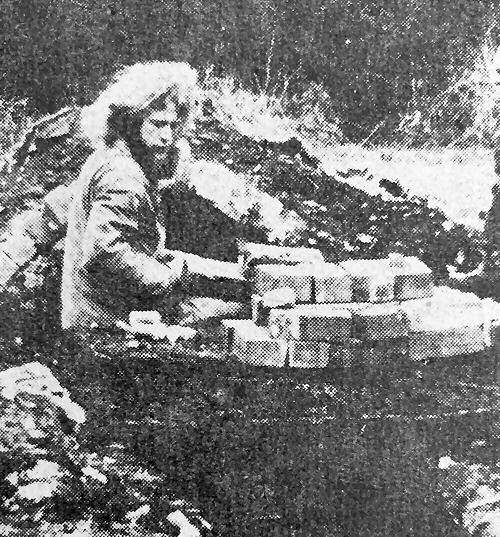
Patrick Sargent
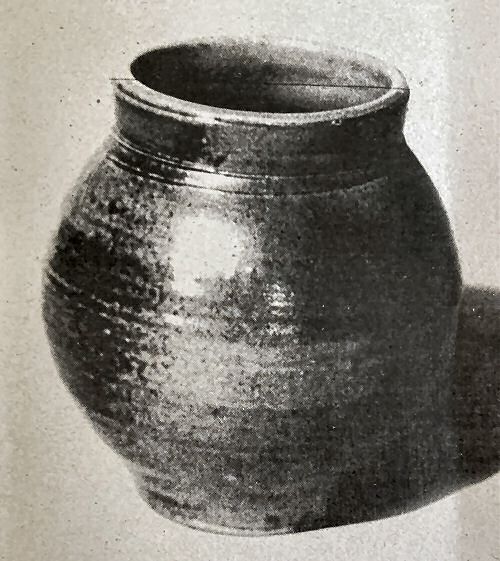
Unglazed jar, fired to 1300oC, glazed by flame and ash
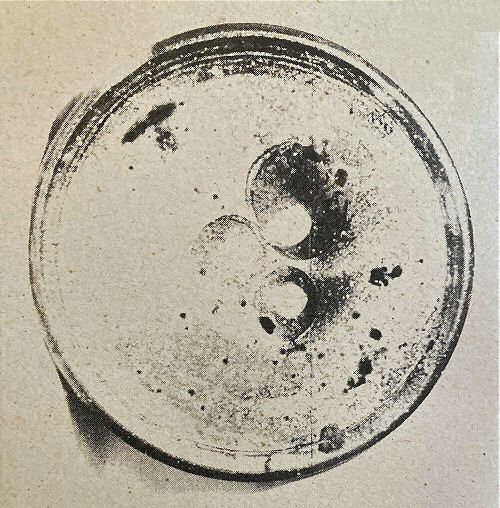
18" shino glazed plate
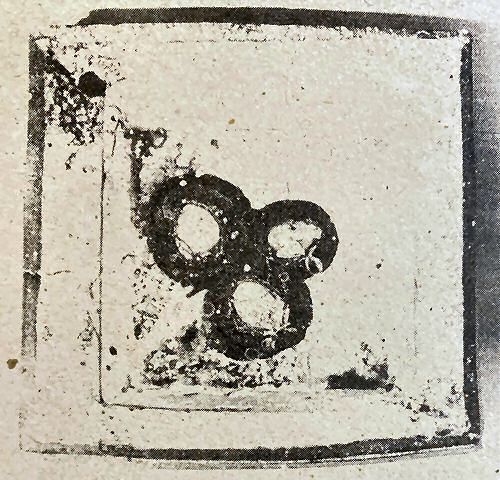
10" dish, shino glazed, ashing from wood
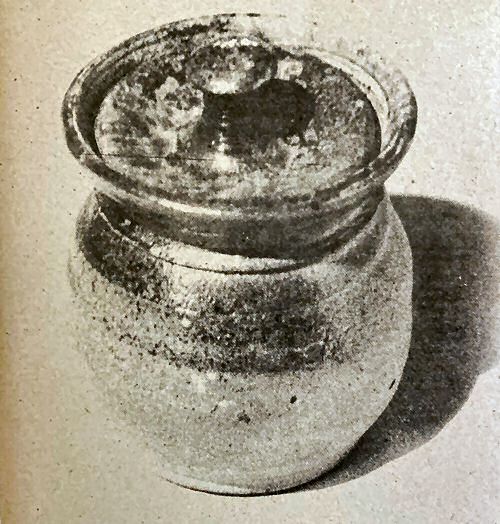
Unglazed jam jar
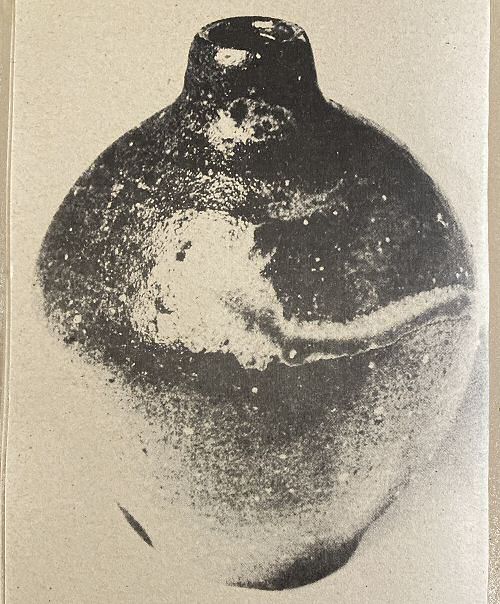
Unglazed 5" bottle, ashing has run down side, flecking from feldspar particles
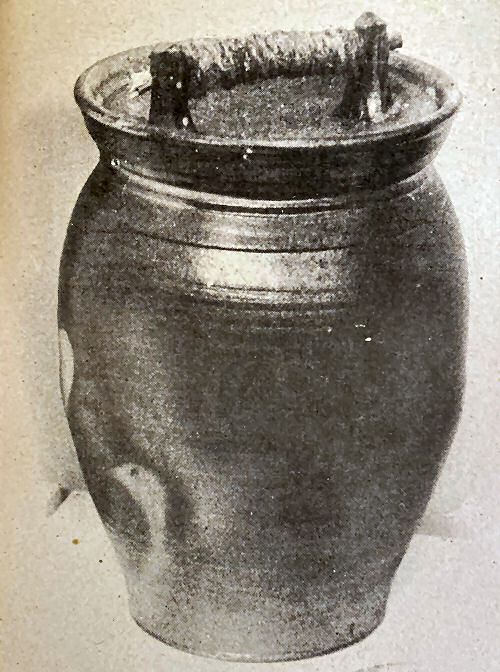
18" unglazed jar, flashing from firing caused by touching other pots
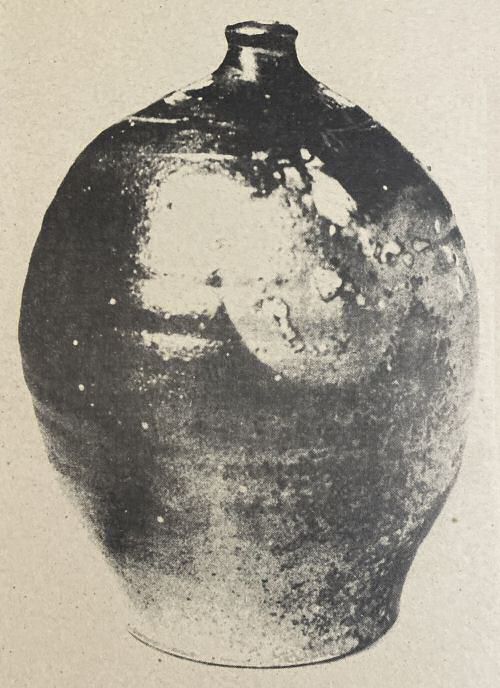
15" unglazed bottle, circles caused by bowls placed on pot which was fired on its side
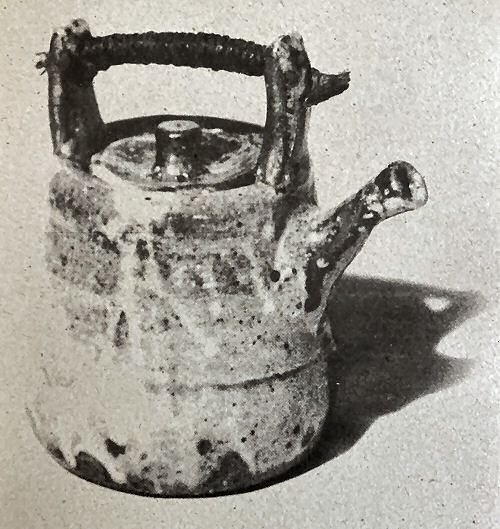
8" shino glazed teapot, fired to 1330oC
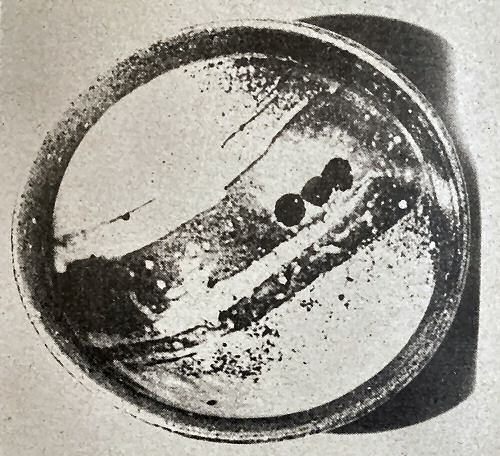
6" shino glazed bowl, wax resist, chrome green dots, ashing
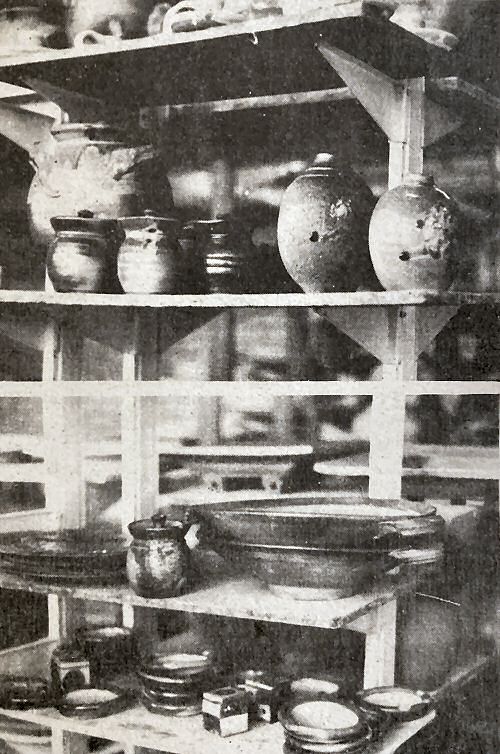
Fired pots
